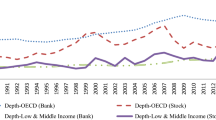Abstract
Using different indicators of financial development, recent empirical studies have discovered various patterns of nonlinearity in the relationship between financial development and economic growth. By adding consumption loans, which are nonproductive, into a standard model of asymmetric information, this paper generates a model that is able to replicate all possible nonlinear finance–growth relationships found in recent empirical studies.
Similar content being viewed by others
References
Alessie R, Hochguertel S, Weber G (2005) Consumer credit: evidence from Italian micro data. J Eur Econ Assoc 3: 144–178
Ausubel LM (1999) Adverse selection in the credit card market, mimeo. University of Maryland
Banerjee A, Duflo E (2004) Do firms want to borrow more? Testing credit constraints using a directed lending program. CEPR Discussion Paper No. 4681
Bencivenga VR, Smith BD (1991) Financial intermediation and endogenous growth. Rev Econ Stud 58: 195–209
Bencivenga VR, Smith BD (1993) Some consequences of credit rationing in an endogenous growth model. J Econ Dyn Control 17: 97–122
Bolton P, Dewatripont M (2005) Contract theory. MIT Press, Cambridge
Bose N (2002) Inflation, the credit market, and economic growth. Oxford Econ Pap 54: 412–434
Bose N, Cothren R (1996) Equilibrium loan contracts and endogenous growth in the presence of asymmetric information. J Monet Econ 38: 363–376
Bose N, Cothren R (1997) Asymmetric information and loan contracts in a neoclassical growth model. J Money Credit Bank 29: 423–439
Capasso S, Mavrotas G (2003) Loan processing costs and information asymmetries—implications for financial sector development and economic growth. Discussion Paper No. 2003/84, United Nations University, World Institute for Development Economics Research
Chan VL, Hu SC (1997) Financial liberalization and aggregate consumption: the evidence from Taiwan. Appl Econ 29: 1525–1535
De Gregorio J, Guidotti P (1995) Financial development and economic growth. World Dev 23: 433–448
Deidda L (2006) Interaction between economic growth and financial development. J Monet Econ 53: 233–248
Deidda L, Fattouh B (2002) Nonlinearity between finance and growth. Econ Lett 74: 339–345
Diamond DW (1984) Financial intermediation and delegated monitoring. Rev Econ Stud 51: 393–414
Edelberg W (2004) Testing for adverse selection and moral hazard in consumer loan markets, FEDS Working Paper No. 2004-09
Fry MJ (1995) Money, interest, and banking in economic development, 2nd edn. Johns Hopkins University Press, Baltimore
Goldsmith RW (1969) Financial structure and development. Yale University Press, New Haven
Greenwood J, Jovanovic B (1990) Financial development, growth, and the distribution of income. J Polit Econ 98: 1076–1107
Ho W-H, Wang Y (2005) Public capital, asymmetric information, and economic growth. Can J Econ 38: 57–79
Hung FS, Cothren R (2002) Credit market development and economic growth. J Econ Bus 54: 219–237
Jappelli T (1990) Who is credit constrained in the U.S. economy. Q J Econ 105: 219–234
Jappelli T, Pagano M (1994) Saving, growth, and liquidity constraints. Q J Econ 109: 83–109
King RG, Levine R (1993a) Finance and growth: Schumpeter might be right. Q J Econ 108: 717–738
King RG, Levine R (1993b) Finance, entrepreneurship, and growth—theory and evidence. J Monet Econ 32: 513–542
Levine R (2004) Finance and growth: theory and evidence, No 10766, NBER Working Papers
Levine R, Loayza N, Beck T (2000) Financial intermediation and growth: causality and causes. J Monet Econ 46: 31–77
Mao J (1970) Models of capital budgeting, E–V vs E–S. J Financ Quant Anal 4: 657–675
McKinnon RI (1973) Money and capital in economic development. Brookings Institution, Washington, DC
Perez SJ (1998) Testing for credit rationing: an application of disequilibrium econometrics. J Macroecon 20: 721–739
Rioja F, Valev N (2004) Does one size fit all? A reexamination of the finance and growth relationship. J Dev Econ 74: 429–447
Romer PM (1986) Increasing returns and long-run growth. J Polit Econ 94: 1002–1037
Saint-Paul G (1992) Technological choice, financial markets and economic development. Eur Econ Rev 36: 763–781
Shaw E (1973) Financial deepening in economic development. Oxford University Press, New York
Shen CH, Lee CC (2006) Same financial development yet different economic growth—why?. J Money Credit Bank 38: 1907–1944
Steijvers T (2004) Existence of credit rationing for SME’s in the Belgian corporate bank loan market, mimeo. Limburgs Universitair Centrum
Author information
Authors and Affiliations
Corresponding author
Rights and permissions
About this article
Cite this article
Hung, FS. Explaining the nonlinear effects of financial development on economic growth. J Econ 97, 41–65 (2009). https://doi.org/10.1007/s00712-008-0057-4
Received:
Accepted:
Published:
Issue Date:
DOI: https://doi.org/10.1007/s00712-008-0057-4




